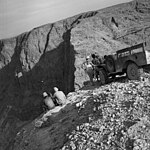| Cave of Horror | |
|---|---|
 Cave of Horror, 1953 Cave of Horror, 1953 | |
 | |
| Location | Ein Gedi, Israel |
| Coordinates | 31°25′48″N 35°20′52″E / 31.43000°N 35.34778°E / 31.43000; 35.34778 |
Cave of Horror (Hebrew: מערת האימה, lit. 'Me'arat Ha'Eima') is the nickname given to a refuge cave that archaeologists have catalogued as Nahal Hever Cave 8 (8Hev) of the Judaean Desert, Israel, where the remains of Jewish refugees from the Bar Kokhba revolt (c. 132–136 AD) were found.
Location
The cave lies in the cliffs towering from the south over the wadi known in Hebrew as Nahal Hever. Nearby, in the cliffs on the opposite side of the stream, is the Cave of Letters, where many documents from the Bar Kokhba revolt were uncovered.
Discoveries
Bar Kokhba revolt
See also: Bar Kokhba refuge cavesAt the top of the cliff above the Cave of Horror were the ruins of a Roman camp, similar to the one found above the Cave of Letters.
The skeletons of 40 men, women and children were discovered inside. Of the 40 dead the names of three are known, since inscribed potsherds (ostraca) bearing their names were found placed on their remains.
In investigations following the first one by Yadin, a number of fragments of letters and writings were discovered in the cave, among them a number of Bar Kokhba coins and a Greek copy of the biblical Book of the Twelve, an already old scroll by the time it was brought into the cave since it was dated to 50-1 BC. Some 60 years later, in March 2021, archaeologists discovered new fragments belonging to the same scroll, a Greek translation of the Book of the Twelve, different from the Septuagint and with the name of God, Yahweh, written in Old Hebrew script among the otherwise Greek text. The newly discovered fragments, which belong to the Books of Zechariah and Nahum, contain surprising variations compared to the Masoretic text commonly used today. No scroll fragments had been discovered by archaeologists in the previous approximately 60 years.
Chalcolithic child burial
The partially mummified 6000-year-old remains of a child, probably a girl aged between 6 and 12, were found in March 2021 under two flat stones in a shallow pit grave with the help of CT (CAT) scan. The burial dates to the Chalcolithic period. The child had been buried in a fetal position and covered with a cloth resembling a small blanket, wrapped around its head and chest, but not its feet. According to the Israel Antiquities Authority the burial was found along with 2,000-year-old Dead Sea scrolls. Fragments were Greek translations of the books of Nahum and Zechariah from the Book of the 12 Minor Prophets. The only text written in Hebrew was the name of God.
See also
References
- ^ "Learn About the Scrolls: Bar Kokhba Revolt Refuge Caves: Nahal Hever Cave 8 (8Hev)". Israel Antiquities Authority: The Leon Levy Dead Sea Scrolls Digital Library. Retrieved 18 March 2021.
- "Judean Desert Caves". Jewish Virtual Library.
- ^ Magness, Jodi (2012). The Archaeology of the Holy Land: From the Destruction of Solomon's Temple to the Muslim Conquest. Cambridge University Press. p. 261. ISBN 9780521124133.
- Dimant, Devorah (2012). The Dead Sea Scrolls in Scholarly Perspective: A History of Research. Brill. p. 385. ISBN 978-9004208063.
- ^ "Featured Scrolls". Israel Antiquities Authority: The Leon Levy Dead Sea Scrolls Digital Library. Retrieved 18 March 2021.
- ^ "New scroll fragments uncovered in the Judean Desert Nature Reserve (Communicated by the IAA Spokesperson)". Jerusalem: Israel Ministry of Foreign Affairs. 16 March 2021. Retrieved 18 March 2021.
- Bhardwaj, Naina. "6,000-year-old child skeleton found in Israel's 'Cave of Horrors' along with ancient Dead Sea scrolls and world's oldest basket". Business Insider. Retrieved 2021-03-29.
- "Israeli researchers announce discovery of new Dead Sea Scroll fragments". The Independent. 2021-03-16. Retrieved 2021-03-29.
- "Ancient child's skeleton found in Israel's 'Cave of Horrors'". South China Morning Post. 2021-03-22. Retrieved 2021-03-29.
- "6,000-year-old child skeleton discovered in Israel". Daily Sabah. Associated Press. 2021-03-22. Retrieved 2021-03-29.
Further reading
- Y. Yadin, The Search for Bar Kokhba - The Discovery of the Judean Desert Caves and the Letters of the Leader of the Revolt against Rome, Maariv, 1976
| Caves in Israel | |
|---|---|
| Israel | |
| Bar Kokhba revolt | |||||||
|---|---|---|---|---|---|---|---|
| Part of the Jewish–Roman wars | |||||||
| Origins |  | ||||||
| Military engagements | |||||||
| Belligerents and leaders |
| ||||||
| Archaeology |
| ||||||
| Aftermath | |||||||
| Related topics | |||||||